50 Years after the Quark Model:
Boiling Quarks.
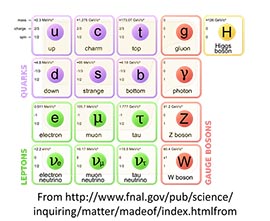
|
| |
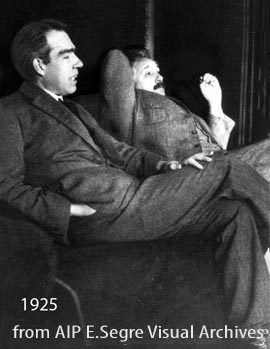
|
| Bohr and Einstein, from the AIP E. Segre Visual Archives. |
Let us go back to 1964. The proton, like other hadrons, is a bound-state of the quarks. However, we are not sure about how the proton looks to a moving observer.
- This problem dates back to the period of Einstein and Bohr. In 1905,
Einstein formulated his special theory of relativity. In 1913, Bohr
started worrying about why the electron energy levels are discreet in the
hydrogen atom.
- Einstein and Bohr met often, and I assume they discussed physics.
I am wondering why Einstein was not interested in the hydrogen atom
and why Bohr was not interested in how the electron orbit looks
to a moving observer.
Why did they not discuss this overlapping issue? Their imaginations could not reach the hydrogen atom moving with a relativistic speed. The H-atom is a neutral particle, and it cannot be accelerated by electric fields. However, these days, the proton is also a bound state of quarks. Then, how would the quark orbits look to a moving observer. Click here for the evolution of the hydrogen atom or the evolution of the way in which we look at this atom.
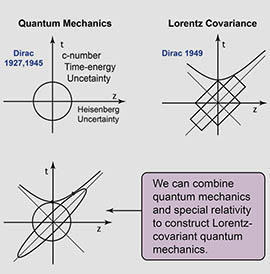
Click here to expand this figure. - Paul A. M. Dirac's lifetime research interest was in combining
quantum mechanics with relativity. His papers are like poems,
and he often used four-by-four matrices and harmonic oscillators in
his poems, but he never used figures or diagrams to illustrate his
ideas.
It was a gratifying experience for me to translate Dirac's poems into the language of Richard Feynman, whose language consisted of figures and diagrams. This figure tells what Dirac told me in 1962, and what I added since then. How did I meet him?
- In so doing, it is possible to combine Dirac's physics based on
mathematical beauty and Feynman's physics which starts from what
we see observe in the real world.
Click here how Dirac's physics
and Feynman's physics can be combined. I have many webpages dedicated
to this issue.
- The combined physics of Dirac and Feynman lead to the resolution
of the quark-parton puzzle: whether the quark model and the parton
model are two limiting cases of one Lorentz-covariant entity.
for the wave page dedicated to this issue.
- Thus, the Gell-Mann - Feynman issue is a Dirac - Feynman issue.
Click here for a story.
- Feynman diagrams tell us how to look at running waves in the
Lorentz-covariant world.
How about standing waves?
- When I write papers, I seem to attempt to combine two seemingly different theories or events into one. According to philosophers, this approach is Hegelian. However, to me, it is simply fun. Indeed, physics is fun. ffffff
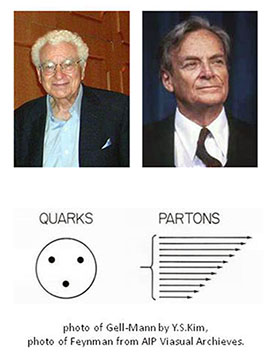
While writing many papers, mostly with Marilyn Noz since 1973, on harmonic oscillators and the Lorentz group, I came across the concepts of
- Squeezed states. Lorentz boosts are squeeze transformations.
- Decoherence. While the quarks are coherent, partons are not.
Click here
for a detailed story of Feynman's parton picture.
- Entanglement. Lorentz boosts entangle space and time variables.
Click here
for entangled harmonic oscillators.
- Time-separation is thoroughly hidden in the present form of quantum
mechanics. What should we do about it?. This variable belongs to
Feynman's rest of the universe.
Click here for a story.
- Entropy and temperature as consequences of our failure to measure
the hidden time separation variable. I published
a paper with Eugene Wigner on this subject.
- Click here for my the latest review article on all these.
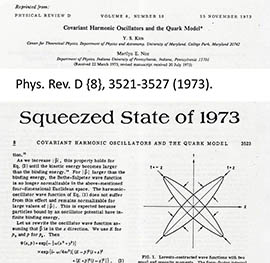
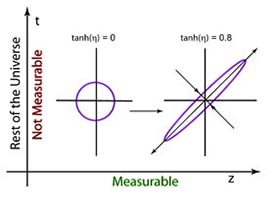
These words are very frequently used in quantum optics and foundations of quantum mechanics these days. For this reason, I sound like an optics man to high-energy physicists, while I am a particle physicists to optics people.
In order to solve this personal problem, I did some research on the people with two different faces. Toyotomi Hideyosi is a very important person in Japanese history, but there are some interesting stories about him.
He looks like a monkey to humans, but he is a human if monkeys look at him. Does this not sound like Einstein?
His face is not familiar to you, but you have seen this castle, which is known as the Osaka Castle. Toyotomi build this castle toward the end of the 16th Century, and he lived there.
In either case, I would love to translate my own papers into web-compatible figures.
- The combined physics of Dirac and Feynman lead to the resolution
of the quark-parton puzzle: whether the quark model and the parton
model are two limiting cases of one Lorentz-covariant entity.
for the wave page dedicated to this issue.
Quarks are confined inside a hadron. Is it possible to boil those quarks?
- It means squeezed states of light in quantum optics.
- This ellipse is used as the conference logo for the
series called ICSSUR. Young people seem to prefer this name
to the original title. The 14th ICSSUR meeting will take
place in 2015 at an interesting place in the world.
- To me, it is an area-preserving transformation which I learned during my high-school years. This figure is very strange to most of the physicists because it is not a unitary transformation.
To me, however, it is the natural language whenever I confront a new problem in physics. The Lorentz transformation is an Einstein issue. Did you know his transformation is a squeeze transformation?
- To me, it is an area-preserving transformation which I learned during my high-school years. This figure is very strange to most of the physicists because it is not a unitary transformation.
- Did you know this figure also means boiling quarks? The quarks
inside a hadron become partons as the hadron moves with a speed
close to that of light. During this transition, the quarks
make a phase transition from a bound state to a plasma state.
-
This figure clearly tells quarks
inside the moving hadron. Then is it possible to list the formulas
relating the hadronic veocity to the temperature?
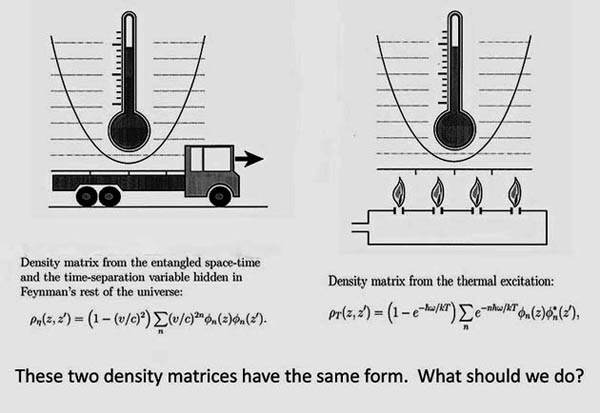
There are two different physical operations in this figure, but their density matrices have the same mathematical form. From this figure, we can calculate the temperature can be calculated from the truck velocity, and here is the result.
Likewise, we can calculate the velocity as a function of the temperature, and we end up with the following figures.

- Click here for 1.5 pdf pages for
the detailed calculations leading to the above figures.
- Physics is fun. It allows us to draw pictures. Wheeler and Feynman were exceptional cartoonists. We now have a new technology: webpages! The webpage seems to allow us to put many things into one box. I have been pursuing this line of research for some years. Please tell me if you have suggestions. Y.S.Kim (2014.5.12)

|
|
You have seen this ellipse before. It means different things to different people.
Did you know this tells also about |
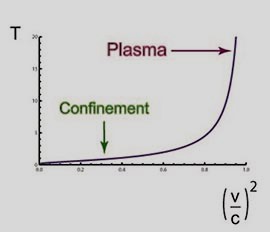
|
copyright@2014 by Y. S. Kim, unless otherwise specified.